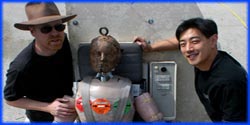


Premier Date: August 1, 2015
confirmed
At the firing range, Adam and Jamie set up a fake lawn consisting of plywood covered with artificial turf and they scattered a line of rocks down its length. Styrofoam blocks painted with human silhouettes were set up in a parallel line to allow them to gauge impacts easily. Adam ran a commercially available self-propelled mower over the rocks, first removing a hinged flap intended to catch debris. He stopped after several feet due to bits of rock debris being thrown back in his face, and the targets showed multiple hits, some of which penetrated the full thickness of the blocks. Jamie’s trial with a riding mower tore up the turf and inflicted many more hits.
At the workshop, they removed the gasoline engine from a mower and replaced it with an electric motor whose speed they could control. They mounted the mower on a thick sheet of acrylic plastic, tilted it backwards, brought the motor up to speed, and lowered it onto the rocks. The blades cut the rocks to pieces and threw them in all directions, with a maximum speed of 400 feet per second (120 m/s). For comparison, Jamie returned to the firing range and fired bullets of various calibers, measuring speeds between 1,000 feet per second (300 m/s) and 1,400 feet per second (430 m/s).
Since the rocks had more mass than the bullets, Adam and Jamie decided to investigate the relative energy carried by each. They built a ballistic pendulum to measure the energy based on how far the pendulum swung up after being struck by a projectile. A test with a .357 Magnum round gave an angle of 60 degrees; with a rock fired from an air cannon at 400 feet per second (120 m/s), the pendulum swung 66 degrees. Since this result meant that the rock was delivering more energy than the bullet, Adam and Jamie declared the myth confirmed.
Jamie then decided to build what he described as the “Lawnmower from Hell,” using a 200-horsepower (150 kW) motor and a 50-pound (23 kg) blade spinning at 5,000 rpm. After he tested it by running over a bucket of water and shredding it, Adam set up a course of other objects, including rocks, wooden pallets, and metal debris. However, as soon as Jamie hit the first obstacle, the blade detached and spun across the grass. He and Adam decided not to test the dangerous machine any further.
busted (tempered glass), plausible (plate glass)
Adam and Jamie molded the head and torso of a human from ballistic gelatin and embedded several bags of simulated blood. At a training facility for fire fighters, they set the dummy in a standing position at the base of a building and hoisted a pane of tempered glass up to the roof. The pane was 4 feet (1.2 m) by 6 feet (1.8 m), with a thickness of 0.375 inches (9.5 mm), and was dropped from a height of 75 feet (23 m).
After their first test resulted in a miss due to the pane drifting off target, Adam designed a guide system to bring it down accurately. Once the system was installed, a second test led to a direct hit but inflicted only crushing injuries on the dummy. When they switched to a pane of plate glass that they had broken to give a sharp edge, the impact cut the dummy into two pieces. Adam and Jamie noted that tempered glass is designed to fracture into small pieces when broken, while plate glass can shatter into dangerous shards; however, being hit by a pane of either type would still lead to fatal injuries. They classified the myth as busted for tempered glass, but plausible for plate glass.
Previous: Episode 230: Flights of Fantasy